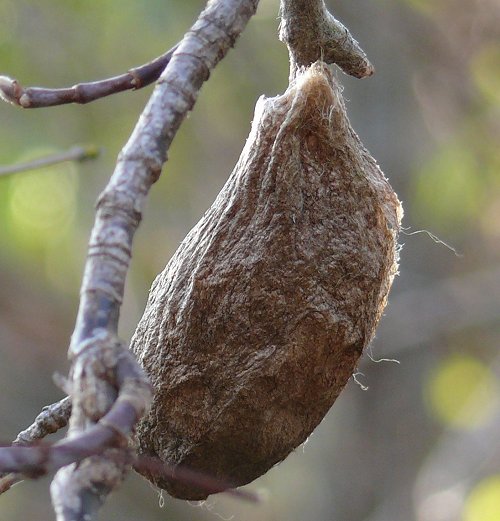While surveying for Daniel Weston in Lincoln to-day, see a great many — maybe a hundred — silvery-brown cocoons, wrinkled and flattish, on young alders in a meadow, three or four inches long, fastened to the main stem and branches at same time, with dry alder and fragments of fern leaves attached to and partially concealing them; of some great moth.
H. D. Thoreau, Journal, December 17, 1853
Cocoons of some great moth. See December 24, 1853 ("The largest are four inches long by two and a half, bag-shaped and wrinkled and partly concealed by dry leaves, — alder, ferns, etc., — attached as if sprinkled over them. This evidence of cunning in so humble a creature is affecting, for I am not ready to refer it to an intelligence which the creature does not share, as much as we do the prerogatives of reason. This radiation of the brain. The bare silvery cocoons would otherwise be too obvious. The worm has evidently said to itself: "Man or some other creature may come by and see my casket. I will disguise it, will hang a screen before it." Brake and sweet-fern and alder leaves are not only loosely sprinkled over it and dangling from it, but often, as it were, pasted close upon and almost incorporated into it.”); January 19, 1854 ("Dr. Harris says that my cocoons found in Lincoln in December are of the Attacus cecropia, the largest of our emperor moths."); February 19, 1854 ("Each and all such disguises and other resources remind us that not some poor worm's instinct merely, as we call it, but the mind of the universe rather, which we share, has been intended upon each particular object. All the wit in the world was brought to bear on each case to secure its end.”); June 2, 1855 ("From that cocoon of the Attacus cecropia which I found — I think it was on the 24th of May . . .came out this forenoon a splendid moth . . ..It was surprising to see the creature unfold and expand before our eyes, the wings gradually elongating, . . .at dusk, when apparently it was waving its wings preparatory to its evening flight, I gave it ether and so saved it in a perfect state.");June 18, 1857 ("They brought me an Attacus Cecropia . . . Its body was large like the one I have preserved"); June 22, 1857 ("It seems that Sophia found an Attacus Cecropia out in my chamber last Monday, or the 15th. It soon went to laying eggs on the window-sill, "); May 6, 1858 ("A boy brings me to-day an Attacus Cecropia moth . . ., the male, a dark brown above, and considerably larger than mine. It must be about seven inches in alar extent."); July 8, 1858 ("I see an emperor moth (Attacus Cecropia), which came out the 6th"):
Cocoons of some great moth. See December 24, 1853 ("The largest are four inches long by two and a half, bag-shaped and wrinkled and partly concealed by dry leaves, — alder, ferns, etc., — attached as if sprinkled over them. This evidence of cunning in so humble a creature is affecting, for I am not ready to refer it to an intelligence which the creature does not share, as much as we do the prerogatives of reason. This radiation of the brain. The bare silvery cocoons would otherwise be too obvious. The worm has evidently said to itself: "Man or some other creature may come by and see my casket. I will disguise it, will hang a screen before it." Brake and sweet-fern and alder leaves are not only loosely sprinkled over it and dangling from it, but often, as it were, pasted close upon and almost incorporated into it.”); January 19, 1854 ("Dr. Harris says that my cocoons found in Lincoln in December are of the Attacus cecropia, the largest of our emperor moths."); February 19, 1854 ("Each and all such disguises and other resources remind us that not some poor worm's instinct merely, as we call it, but the mind of the universe rather, which we share, has been intended upon each particular object. All the wit in the world was brought to bear on each case to secure its end.”); June 2, 1855 ("From that cocoon of the Attacus cecropia which I found — I think it was on the 24th of May . . .came out this forenoon a splendid moth . . ..It was surprising to see the creature unfold and expand before our eyes, the wings gradually elongating, . . .at dusk, when apparently it was waving its wings preparatory to its evening flight, I gave it ether and so saved it in a perfect state.");June 18, 1857 ("They brought me an Attacus Cecropia . . . Its body was large like the one I have preserved"); June 22, 1857 ("It seems that Sophia found an Attacus Cecropia out in my chamber last Monday, or the 15th. It soon went to laying eggs on the window-sill, "); May 6, 1858 ("A boy brings me to-day an Attacus Cecropia moth . . ., the male, a dark brown above, and considerably larger than mine. It must be about seven inches in alar extent."); July 8, 1858 ("I see an emperor moth (Attacus Cecropia), which came out the 6th"):



No comments:
Post a Comment